Chipping Away: Assessing and Addressing the Labor Market Gap Facing the U.S. Semiconductor Industry – Semiconductor Industry Association
Semiconductors are at the heart of America’s strength, enabling the essential technologies that drive economic growth and national security. With demand for semiconductors projected to increase significantly by 2030 and beyond, semiconductor companies are ramping up production and innovation to keep pace.
Fortunately, thanks in large part to enactment of the landmark CHIPS and Science Act of 2022, a significant share of new chip manufacturing capacity and R&D is expected to be located in the U.S. But as America’s semiconductor ecosystem expands in the years ahead, so too will its demand for semiconductor workers with the skills, training, and education needed in the highly innovative semiconductor industry.
We project the semiconductor industry’s workforce will grow by nearly 115,000 jobs by 2030, from approximately 345,000 jobs today to approximately 460,000 jobs by the end of the decade, representing 33% growth. Of these new jobs, we estimate roughly 67,000—or 58% of projected new jobs (and 80% of projected new technical jobs)—risk going unfilled at current degree completion rates. Of the unfilled jobs, 39% will be technicians, most of whom will have certificates or two-year degrees; 35% will be engineers with four-year degrees or computer scientists; and 26% will be engineers at the master’s or PhD level.
Download the Executive Summary
View the Press Release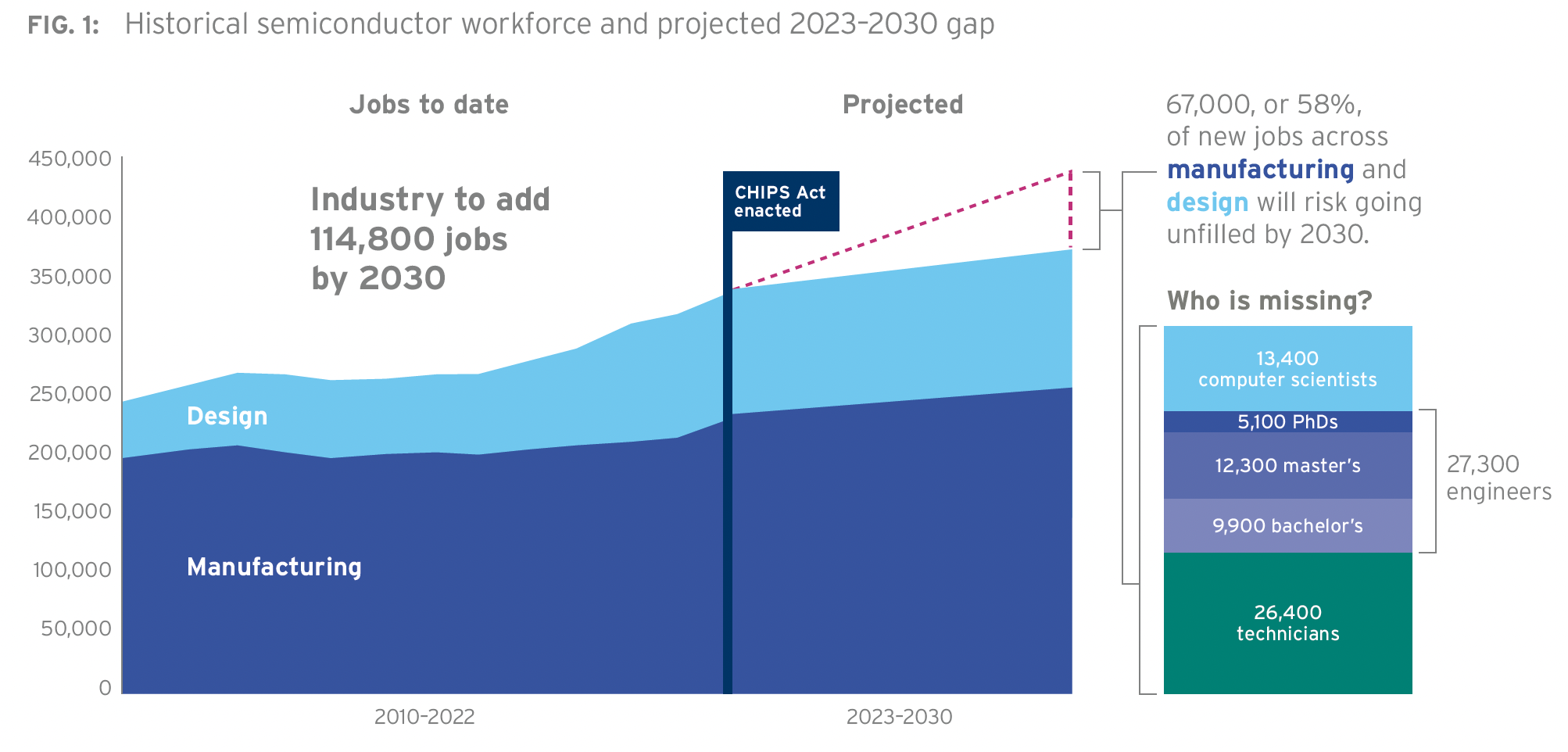
The challenge facing the semiconductor industry in closing this labor market gap also confronts the U.S. economy as a whole. Other high-growth technology industries of strategic importance to the future of the U.S. and the world are facing a similar talent gap and are competing for the same pool of trained workers. These industries and technologies include clean energy, medical technology, artificial intelligence, the Internet of Things, cybersecurity, next-generation communications, aerospace, automotive, and advanced manufacturing, among others. Accordingly, the shortage of skilled workers poses a substantial challenge for both the semiconductor industry and the broader U.S. economy.
The numbers are striking. For the economy as a whole, by the end of 2030, an estimated 3.85 million additional jobs requiring proficiency in technical fields will be created in the U.S. Of those, 1.4 million jobs risk going unfilled unless we can expand the pipeline for such workers in fields such as skilled technicians, engineering, and computer science.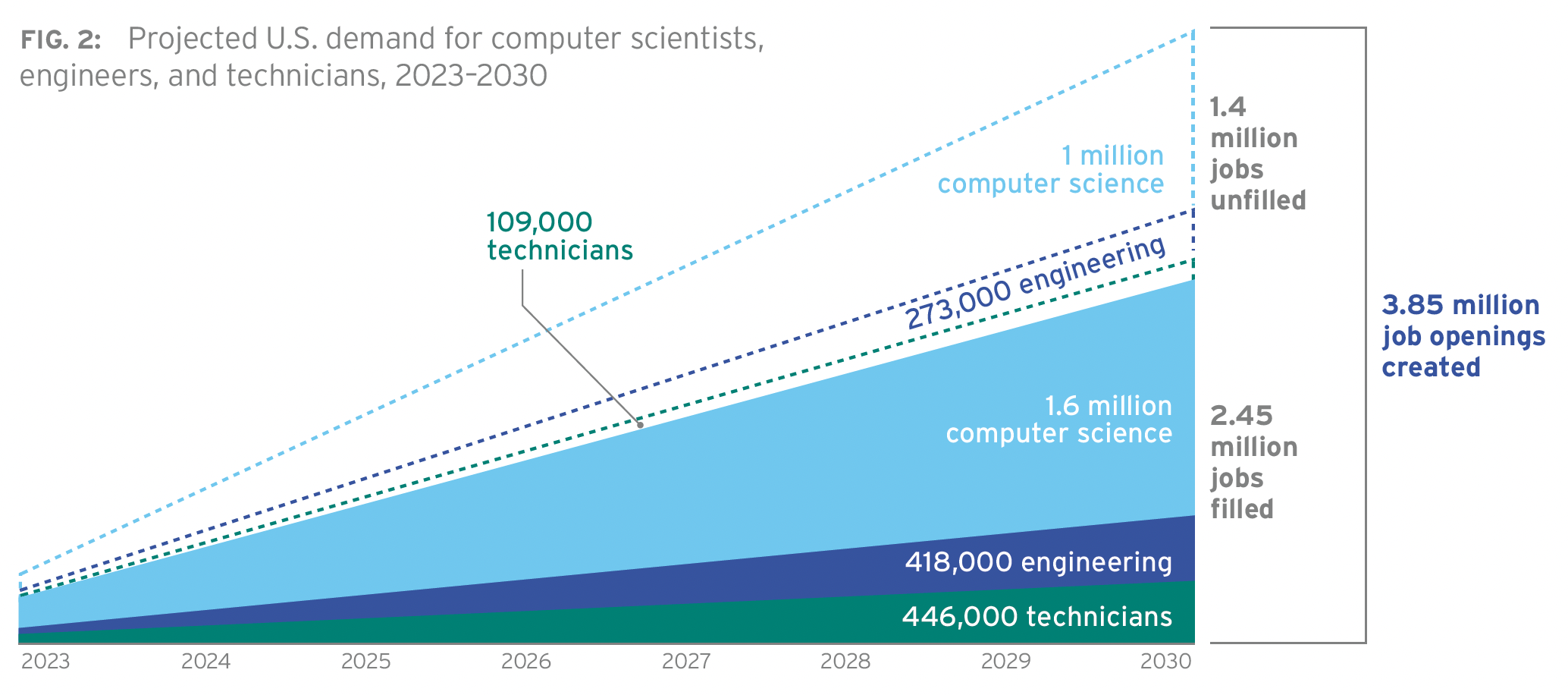
Closing the talent gap is of critical importance to the success of the U.S. economy and the semiconductor industry. While the technology sector, broadly, needs to work together to address these challenges, semiconductors are foundational to virtually all the critical technologies of the future. Addressing the challenge for the semiconductor industry, first and foremost, will be central to the promotion of growth and innovation throughout the economy. But the gap in technical talent facing the chip industry is only a fraction of the overall challenge facing the economy.
The U.S. semiconductor industry has, for decades, engaged in programs to recruit, train, and employ a diverse and skilled workforce. Across the nation, chip firms have longstanding and expanding partnerships with community colleges and technical schools, apprenticeship programs, universities and laboratories, and regional education networks. As the industry grows to meet demand alongside CHIPS investments, companies are growing their workforce development footprint. At the same time, the U.S. government must work with industry and academia to prioritize measures to address the skills gap facing the broader economy and the semiconductor industry. To help achieve this goal, we present three core recommendations to strengthen the U.S. technical workforce.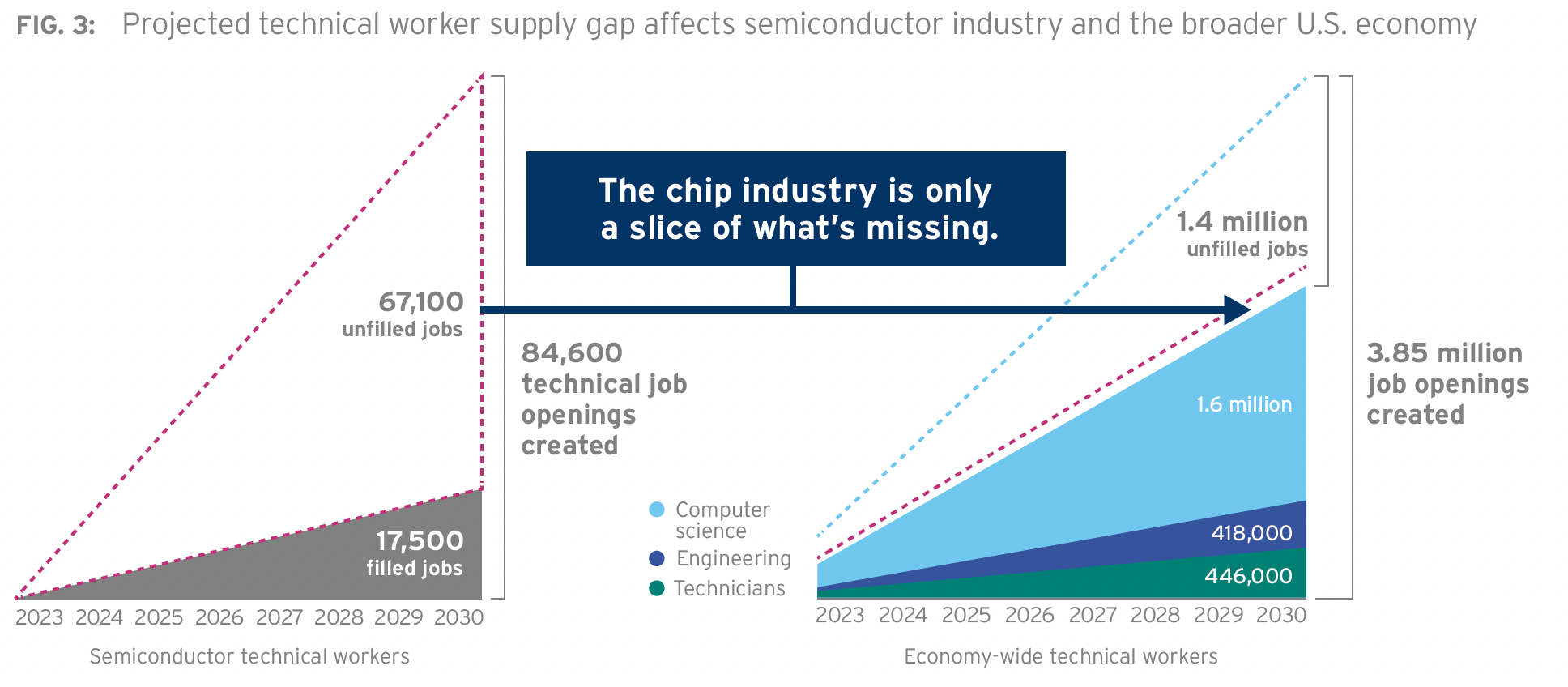
Expanding certification boot camps, apprenticeships, and other training programs at community and technical colleges located near new and expanding semiconductor fabs would be an effective means to help close the workforce gap for technicians. Curricula and education solutions tailored to the semiconductor industry will ensure students are prepared for future employment. The technician pipeline is robust and pulls from a wide variety of sources, such as high school graduates and returning veterans. Improving current trajectories of talent supply and demand will be an uphill battle, and companies in the semiconductor industry are already taking action. The CHIPS and Science Act also provides excellent support in closing this gap and should continue to assist industry-led efforts to bolster the technician workforce.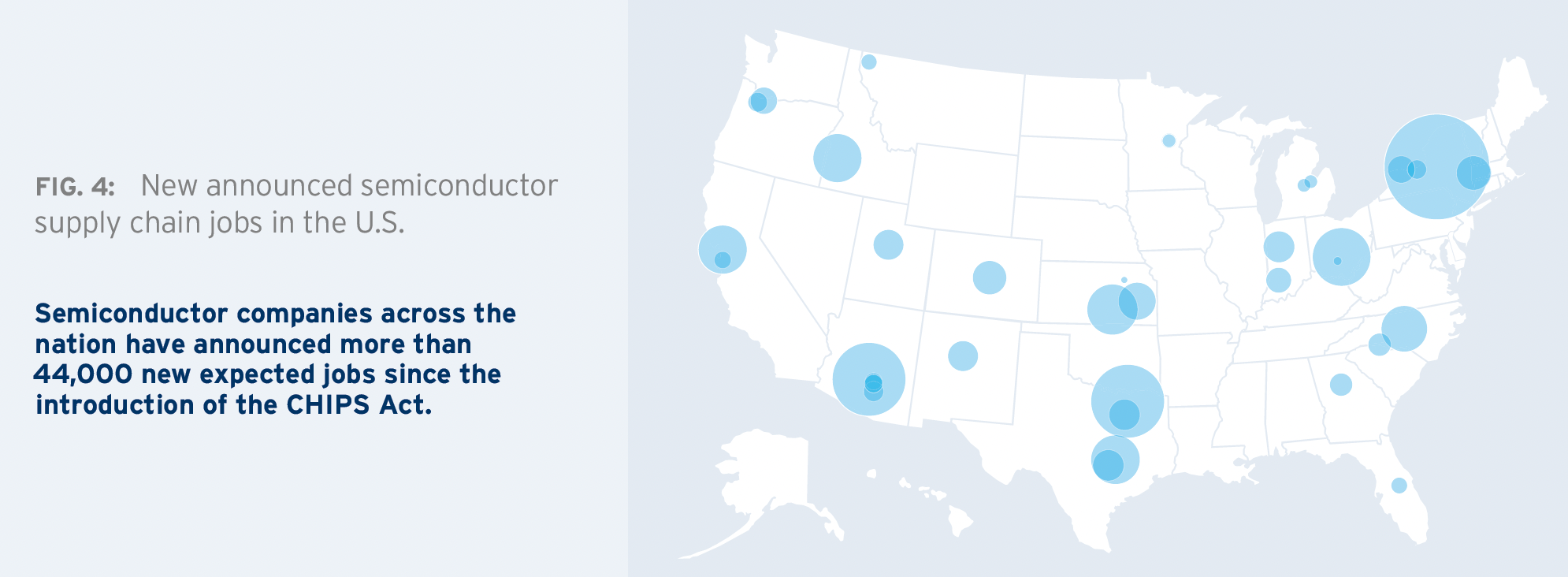
Our analysis shows that an insufficient number of students are pursuing STEM degrees to meet the labor market demand, and many of those who graduate with STEM degrees do not enter a STEM occupation. An even smaller number of these graduates enter the semiconductor industry. Policies should be undertaken to expand this pipeline in three stages:
The CHIPS and Science Act provides significant potential support for advancing the above three objectives by establishing the National Semiconductor Technology Center, the semiconductor-focused Manufacturing USA Institutes, the National Advanced Packaging Manufacturing Program, expanded NIST metrology research, the Department of Defense Microelectronics Commons, the National Science Foundation CHIPS Workforce and Education Fund, and other institutions. These initiatives represent an important step forward, but more must be done. Our analysis shows that enhancing the domestic pipeline for STEM talent, especially at the master’s and PhD level, is a generational challenge. The U.S. needs to act today to move forward aggressively if it is to fully meet the industry’s demand for technical talent by 2030.
The process of growing the domestic pipeline of U.S.-citizen students pursuing advanced degrees in STEM fields will take years or decades to bear fruit. In the meantime, we estimate that approximately 16,000 master’s- and PhD-level international engineers are leaving the U.S. each year. For the semiconductor industry alone, these departures contribute to a projected total gap of approximately 17,000 master’s and PhD engineers by the end of the decade. Simply put, the workforce gap for individuals with advanced engineering and computer science degrees cannot be realistically addressed for the foreseeable future solely with U.S.-citizen graduates.
At U.S. colleges and universities, over 50% of master’s engineering graduates and over 60% of PhD engineering graduates are foreign citizens. Approximately 80% of master’s and 25% of foreign PhD STEM graduates from U.S. institutions do not remain in the U.S. after graduating, either by choice or because of U.S. immigration policy.
Such high shares imply that providing easier pathways to permanent U.S. residency has the potential to provide an immediate boost to the domestic talent pool available to the semiconductor industry and other technology industries of strategic importance. Reforms to high-skilled immigration policy that lower the barriers to U.S. firms seeking to recruit and retain international students with advanced degrees can help to meet near-term skills gaps facing the semiconductor and other key technology industries.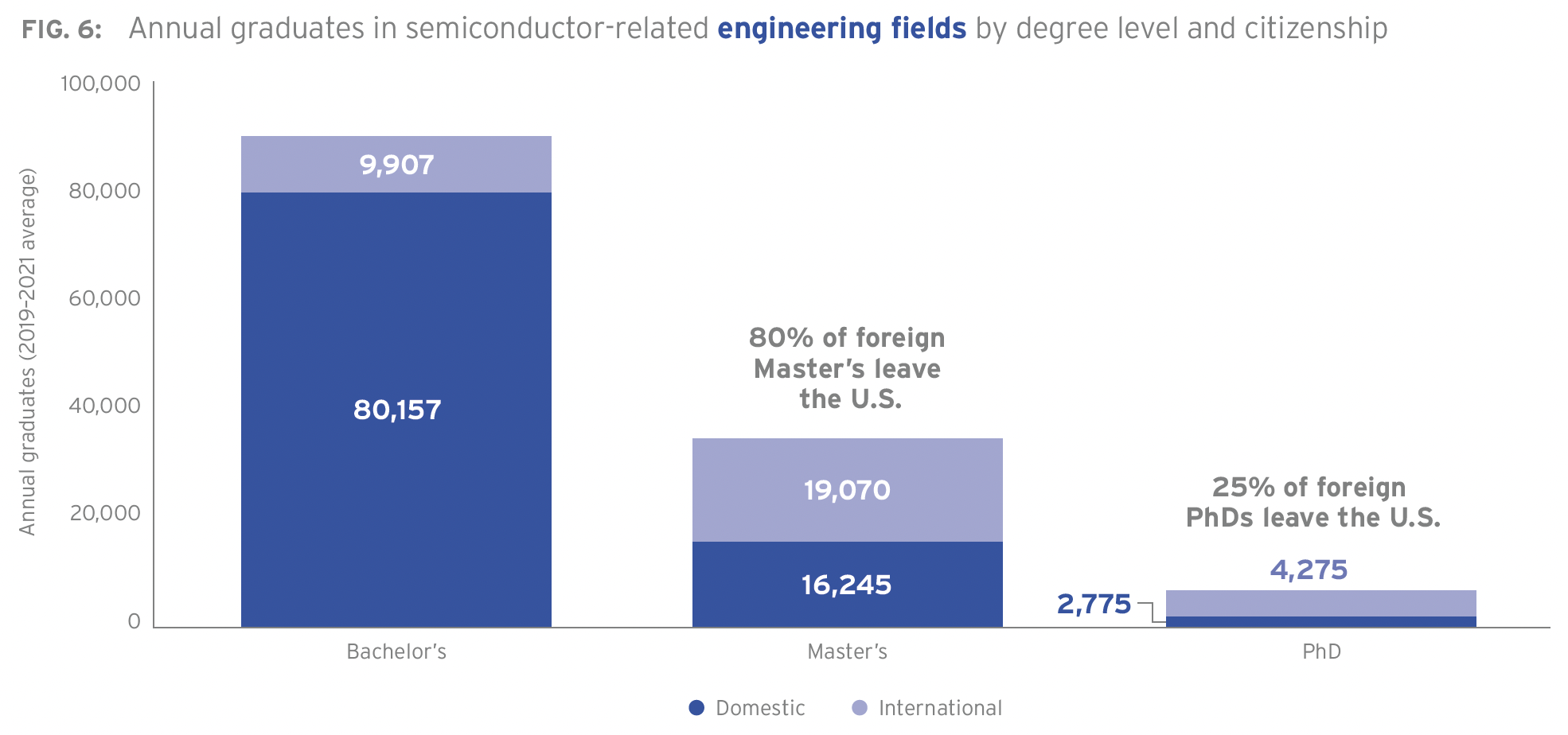
A sustainable and predictable supply of technicians, engineers, and CS professionals across all industries is vital for U.S. national security, competitiveness, and innovation—and to guarantee the supply of the end products American consumers and businesses demand. The success of U.S. semiconductor manufacturing, design, and R&D depends on leadership from industry, government, and education to rise to the challenge and maximize the generational opportunity that lies ahead.
Download the Full Report
1101 K Street NW Suite 450, Washington, DC 20005
E-mail
